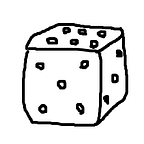Exploding dice: adding standard dice
Last time, we looked at exploding dice and canonical geometric dice, each of which had its problems. Our goal is to find a scheme that:
- Allows us to control the width of our distribution.
- Stays as close to standard dice as possible.
- Isn’t too complicated or time-consuming to roll.
Choosing a half-life
To the first point, the geometric distribution has exactly one parameter, and that parameter directly scales its width. There’s several ways of expressing this parameter, but I’m going to go with the amount of attack bonus needed to halve the opponent’s EHP (as long as we aren’t already at 100% hit chance), which I’m going to call the half-life. Technically this isn’t exactly what it meant in its original context, but it sounds cool, and we are literally halving the expected lifespan of the defender.
Why half?
- It makes for a convenient reference on how much each point of bonus is worth.
- For an ideal geometric distribution, the median roll is equal to the half-life.
Favored choices
Here are my favored choices for half-life.
- Half-life = 3. This makes the probability resemble decibels: not only does 3 points represent a factor of 2 in probability, but 10 points represents close to a factor of 10. Each number is 1.260 times more likely to be rolled than the next.
- Half-life = 5. We humans consider 5 a round number. Another convenience is 3 points represents close to a factor of 1.5, and likewise 8 points represents close to a factor of 3. Each number is 1.149 times more likely to be rolled than the next.
Choosing an exploding die
With desired values for half-life in mind, we‘ll try exploding dice again, but choosing more carefully this time. An exploding die has an asymptotic half-life equal to
(exploding face) / log2(1 / explode chance)
For standard dice we have:
- d4: half-life = 2
- d6: half-life = 2.32
- d8: half-life = 2.67
- d10: half-life = 3.01
- d12: half-life = 3.35
- d20: half-life = 4.63
So an exploding d10 is a good choice for a half-life of 3, but even a d20 doesn’t achieve a half-life of 5.
Fortunately, there is a simple way to get a half-life of 5: take a d12 and treat any roll of 10+ as an exploding 10. While not quite a standard exploding die, it’s easy to remember, and actually follows a geometric distribution better than a standard exploding d10. The one downside is that the 25% explode chance is a bit high, which makes rolling slightly more time-consuming on average.
Adding non-exploding dice
As we’ve seen before, standard exploding dice alone don’t do a great job of following a geometric distribution.
What happens if we add some standard, non-exploding dice? When we add dice together, this has the effect of convolving their probability distributions. For standard dice, this smooths out the distribution they are added to, in the same way that a moving average smooths out a time series.
Let’s see what happens to our EHP plots when we add 1d10 or 2d6 to the exploding dice above. (I chose 1d10 because it’s the largest single-digit die, and 2d6 because d6s are the easiest dice to come by, but these are just examples.) We’ll again use a logarithmic vertical scale, which makes the ideal geometric distribution a straight line.
Half-life = 3 (AnyDice):
Half-life = 5 (AnyDice):
We can observe the following:
- Adding standard dice makes the right tail follow a geometric distribution more closely by smoothing out the bumps in the exploding die.
- The distribution gains a (short) left tail. In other words, the chance of success doesn’t go to 100% as quickly as a geometric distribution, which goes from 50% to 100% in a single half-life. While this doesn’t follow a pure geometric distribution, this may actually be a good thing in practice if we want to make guaranteed successes harder to achieve than with a pure geometric distribution.
Roughly speaking, the greater the variance of the standard dice we add, the longer the left tail and the smoother the right tail.
So there we have it: an implementation of a geometric-ish distribution that uses one standard or almost-standard exploding die plus one or two standard dice. Next time, we’ll finish up by looking at opposed rolls with exploding dice.
